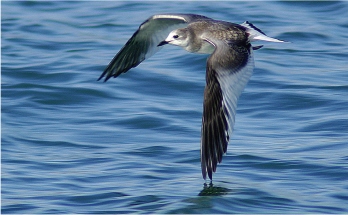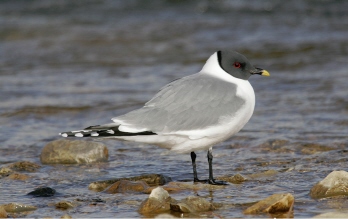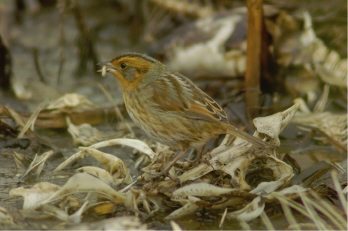The Reluctant Twitcher (14 page)

We load McRae up and send him lurching ahead on the trail. I offer to carry his bins but pointedly do not insist that he call me “Boss Pope” henceforth.
Upon arrival, we decide on the best site, get ourselves organized and our chairs set up, and begin. Ta-dah: Ladies and Gentlemen â The Big Sit!
The owls betray us and even refuse to respond to Doug's shrieking Saw-whet tapes. Oh, well, as the Russians say, beginnings are a bad business. Things will look up.
They do, shortly after first light.
Doug espies a suspicious white form on the beach about thirty yards away and goes over to check it out. He is thrilled. It is a dead Sabine's Gull in almost perfect condition. I would have been slightly more thrilled with a live one, but this stiff is good enough for Doug. He talks a lot about putting it in his freezer, allegedly for Mark Peck, who collects avian corpses avidly. Doug looks forward to skinning it out tonight. I remember hearing somewhere that he eats the dead birds he finds, but this can scarcely be true, though his cousin, none other than John Carley, swears it is well-attested. Still, you have to wonder. He didn't bring a very big lunch. It's not every day you get to bird with the necrophagous. Bird carcasses remain a dominant leitmotif of Doug's conversation the rest of the day, arousing further suspicions.

Photo by
Barry S. Cherriere.
Sabine's Gull (juvenile). Fort Erie. Young birds like this are the ones we
usually see in Southern Ontario in the autumn.

Photo by
Mark Peck.
Sabine's Gull (adult in breeding plumage). Cambridge Bay, Nunavut.
This is how they look on their breeding grounds.
As the morning warms up, I keep an eye on the Sabine's. It only has to twitch or move an eyelid and it is going on my list. I long for a cattle prod. But sadly the gull stays very dead. It is an ex-gull.
It is a slow day, but in the end we get fifty-five species, two of which are new for my year. I have somehow failed to see a
Peregrine Falcon
(280) all year, but here we have them buzzing around us all day; twelve sightings of at least five different birds.
In late morning, Doug spots the bird we have all being hoping we might see: a
jaeger â Parasitic
(281) as it turns out. I actually see the bird first but am damned if I am going to call a jaeger in front of Doug and Margaret and have it turn out to be a juvenile Herring Gull or something and then collapse in racking sobs on the sand as they spend the rest of the day saying it could have happened to anybody and how easy it is to confuse these two quite distinct birds. Another brush with fame missed. But we are all happy with a jaeger; especially Margaret and I, since we both
need
a jaeger. We knew they must go by Presqu'ile in October and are rewarded with two Parasitics by day's end.
The only mood-spoiler is watching birds die all around us of avian botulism at an alarming rate â well, alarming to the well-fed. A seemingly healthy Great Black-backed Gull flies in and lands well out in front of us. Four hours later its head is low to the water. Two more hours and its head and neck are on the water, and it is dead eight hours after it flew in. I restrain myself from saying to McRae, “Good eatin', I hear.” I must not encourage morbid habits. A lone Greater Yellowlegs stands motionless all day and has not quite keeled over by the time we quit. I keep my eye on McRae. I am really partial to Greater Yellowlegs. Had it been a mere Lesser, I'd have said, “Bon appétit.” Other ducks, gulls, and cormorants show varying degrees of distress as they slowly die. McRae feigns sorrow, obviously calculating how quickly he can get back after we leave. We can land on the moon, but seem unable to do much about this form of botulism.
Day's end is around dusk. I soon realize it would be pusillanimous in the extreme to suggest stopping after a mere twelve hours or so. Margaret and Doug are serious birders. You have to learn to suffer if you're going to play with the big leaguers. At least I'm not hungry, and carrying the coolers back to the car is a lot easier at the end of the day.
I am happy with two new species for a total of 281. Birds are coming with less frequency by early October. And the Big Sit is really fun. You certainly have lots of time to catch up on each other's news and the inside tales of the profession.
Try one; you might like it. Just be sure to sit well away from bushes and watch out for those guys with white coats and throw-nets that creep around all day trying to get close.

Ah, but a man's reach should exceed his grasp,
or what's a heaven for?
â R
OBERT
B
ROWNING
,
A
NDREA
D
EL
S
ARTO
G
OTTA
go, go, go. The day after The Big Sit, Hugh and I are off in the early morning to Hamilton to try for Nelson's Sharp-tailed Sparrow (now known as Nelson's Sparrow) at Cootes Paradise. Margaret can't go and is very bitter. She knows Hugh and I get the bird here every year and know just where to go.
We meet a birder on the way into the marsh who ecstatically tells us that the Franklin's Gull has just flown the coop. I do not say that I don't give a tinker's damn for the gull, but I want to. Badly.
Hugh and I go right to where we expect to find the sparrow and the bird is not there. Hughie becomes despondent. We proceed to the end of the trail, where the gull was, and where we have had Sharp-tailed before. We don't find either bird. The
Reisefuehrer's
mood darkens. We return to where we always get the sparrow for another try. A White Pelican flies right over us.
“Just our luck,” says Hugh darkly. We saw hundreds of them in Rainy River. I ask him if he's having any fun at all, but he is not to be jollied out of his sombre mood.
We decide to try the chest-high grasses across the pond from our usual lucky spot and immediately have a
Nelson's Sharp-tailed
(282) pop up and sit for us for over a minute. The shadow of death lifts instantly. It is the best look Hugh has ever had of the sparrow, though he says this every year.
“That was a pretty neat pelican, wasn't it?” says Hugh on our way out.
I pay for this Sharp-tailed later. Margaret and I try for one repeatedly all around Cobourg. I really want to help her get one. She sends me through acres of beggar ticks and I ruin a number of pairs of socks before she finally gets the bird â in downtown Cobourg.
On October 9, Margaret and I rush off to Prince Edward Point. David Okines has reported a Myiarchus flycatcher that did not seem to be a Great Crested. Hugh is tied up with bridge but says darkly, “It's probably just an Ash-throated or a one-day wonder, but call me tonight if you find it and it's something good.” Ash-throated will be okay with me, I think to myself. But Margaret and I are to be thwarted. The bird is not there and oddly never shows up again. I say oddly, because usually such birds turn up again as soon as I leave the area. However, there are compensations. We get a Goshawk for Margaret and then we get a bird we both
need
:
Golden Eagle
(283). It is an immature bird and we are the first to get one this year. They don't start showing up regularly for another three weeks or so. This is but one of a number of birds that I find more attractive in juvenile plumage.

Photo by
Barry S. Cherriere.
Nelson's Sharp-tailed Sparrow. Paradise Pond, Dundas Marsh. This bird
came out of hiding in tall grass to eat grubs in the remains of a dead carp.
On October 10, Jim Fairchild phones to tell me he has just found a Hudsonian Godwit in Lynde Marsh. Margaret and I rush off the following day. The bird is not to be found from the viewing platform or the first trail into the marsh. We work our way south through impenetrable tangles, finding everything but Hudsonian. We do, however, spot the four Long-billed Dowitchers that Jim spoke of, and this spurs us on. We sink into black muck and I have to lift Margaret's right leg over the huge blown-down black willows, but she soldiers on, fearful lest I get the bird up ahead without her. It is a long walk back for Margaret. My walk seems short because Margaret points out a Cackling Goose flying right over us with a bunch of Canadas. I
need
Cackling Goose
(284), even if she does not. It is another bird I did not bother to go see when it was available (in the Cobourg Harbour in January) because I was so sure I'd see tons later.
October 12 finds the intrepid team of Dave Beadle, Currie, and Pope heading west to the OFO Convention at Point Pelee. I have high hopes for this weekend, especially since we have Beadle with us. If something peeps, Beadle will be all over it.
We stop at Hillman's Marsh on the way into town. A woman in the parking lot has just seen several hundred Soras or some such thing, and my hopes fly high. I still
need
Sora and Orange-crowned Warbler. We set up for rails and something tiny flits away out of a shrub and instantly disappears. Beadle asks, “You still need Orange-crowned?”
“Big time,” I say.
“Well, that was an Orange-crowned just now,” says Dave. I am about to say, “yeah, sure,” but remembering it's Beadle I'm with, I race off after the bird. Guess what?
Orange-crowned Warbler
(285) â an auspicious beginning, even if there wasn't a Sora within miles.
October 13 and still no bloody Sora, though I hang around marshes all day. Spikey Pike tells us they are still around out in the pond where he has been in his canoe. There is hope. No new bird today. Hope fades.
On October 14 my only request is to start out the day early at the Marsh Boardwalk. To humour me, the others agree. We walk out seventy metres and I find a
Sora
(286) warming up in the first morning sun and get it in my new Zeiss scope at fifty power. Nicest Sora
I
ever saw. Even Dave is impressed.